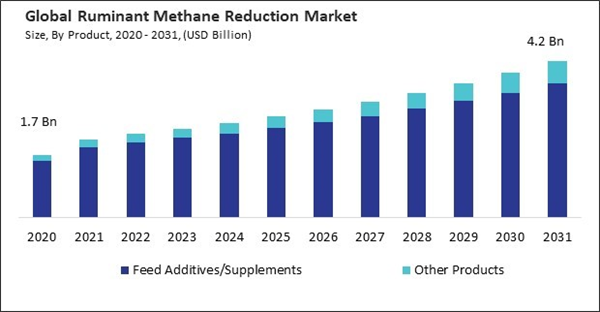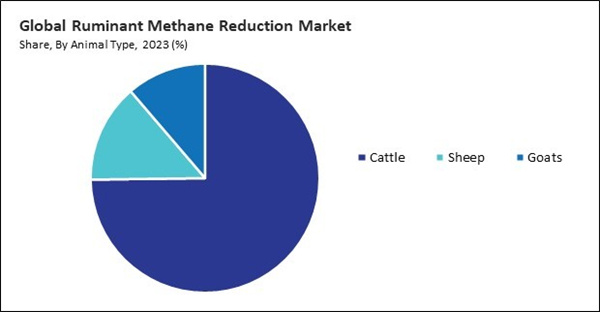Microbial-based feed additives, such as those containing specific strains of bacteria or archaea, can help reduce methane emissions by altering the microbial population in the rumen, where methane is produced during digestion. Thus, the microbial-based segment acquired 52.4% revenue share by product type in the market 2023.These additives can improve feed efficiency and reduce methane production per unit of feed consumed.
Methane, the primary greenhouse gas emitted by ruminant livestock, is significantly more potent than carbon dioxide in heat-trapping ability, especially in the short term. While carbon dioxide remains in the atmosphere for centuries, methane has a much shorter atmospheric lifetime but a much higher global warming potential over a 20-year year.
Additionally, as more cattle, sheep, and goats are raised for meat and dairy production, the methane output from enteric fermentation in ruminant digestive systems rises. This exacerbates the environmental impact of agriculture on climate change and underscores the urgency of addressing methane emissions from ruminants. Hence, the increasing livestock population worldwide is driving the market's growth.
However, implementing methane reduction technologies and practices often requires significant upfront investment in infrastructure, equipment, and technology. For example, installing methane capture systems, purchasing specialized feed additives, or retrofitting existing facilities to accommodate methane reduction measures can incur substantial costs for livestock producers.
Driving and Restraining Factors
Drivers- Rising environmental and climate change concerns
- Expansion of the animal feed industry
- Increasing population of livestock worldwide
- High infrastructure, equipment, and technology costs
- Complexity of the ruminant digestive system
- Emergence of carbon farming programs
- Growing research and development investments
- Long gestation period for technology adoption
- Lack of livestock diversity and genetic considerations
Animal Type Outlook
On the basis of animal type, the market is segmented into cattle, sheep, and goats. In 2023, the goats segment attained 11.3% revenue share in the market. The goat farming industry is experiencing significant growth worldwide due to increasing demand for goat meat, milk, and other products.Products Outlook
Based on product, the market is divided into feed additives/supplements and other products. In 2023, the other products segment acquired 10.7% revenue share in the market. Some technologies aim to capture methane emissions directly from ruminants and convert them into usable energy, such as biogas or electricity.Regional Outlook
Region-wise, the market is analyzed across North America, Europe, Asia Pacific, and LAMEA. The Asia Pacific region generated 27.2% revenue share in the market in 2023. Rapid industrialization, urbanization, and agricultural intensification in many parts of Asia Pacific have led to environmental degradation and pollution.List of Key Companies Profiled
- DSM-Firmenich
- Alltech, Inc.
- Fonterra Co-operative Group Limited
- Elanco Animal Health, Inc.
- Cargill, Incorporated
- Blue Ocean Barns
- CH4 GLOBAL, INC.
- Mootral
- Symbrosia Inc.
- Rumin8 Ltd
Market Report Segmentation
By Product- Feed Additives/Supplements
- Microbial-based
- Plant-based
- Chemical-based
- Other Products
- Cattle
- Sheep
- Goats
- North America
- US
- Canada
- Mexico
- Rest of North America
- Europe
- Germany
- UK
- France
- Russia
- Spain
- Italy
- Rest of Europe
- Asia Pacific
- China
- Japan
- India
- South Korea
- Australia
- Malaysia
- Rest of Asia Pacific
- LAMEA
- Brazil
- Argentina
- UAE
- Saudi Arabia
- South Africa
- Nigeria
- Rest of LAMEA
Table of Contents
Companies Mentioned
- DSM-Firmenich
- Alltech, Inc.
- Fonterra Co-operative Group Limited
- Elanco Animal Health, Inc.
- Cargill, Incorporated
- Blue Ocean Barns
- CH4 GLOBAL, INC.
- Mootral
- Symbrosia Inc.
- Rumin8 Ltd










